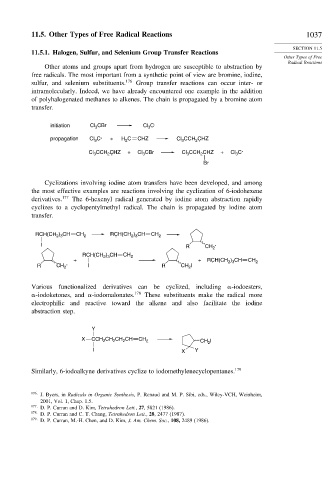Page 1053 - Advanced Organic Chemistry Part A - Structure and Mechanisms, 5th ed (2007) - Carey _ Sundberg
P. 1053
11.5. Other Types of Free Radical Reactions 1037
SECTION 11.5
11.5.1. Halogen, Sulfur, and Selenium Group Transfer Reactions
Other Types of Free
Radical Reactions
Other atoms and groups apart from hydrogen are susceptible to abstraction by
free radicals. The most important from a synthetic point of view are bromine, iodine,
sulfur, and selenium substituents. 176 Group transfer reactions can occur inter- or
intramolecularly. Indeed, we have already encountered one example in the addition
of polyhalogenated methanes to alkenes. The chain is propagated by a bromine atom
transfer.
initiation Cl CBr Cl 3 C .
3
propagation Cl C . + H C CHZ Cl 3 CCH CHZ
2 .
3
2
Cl 3 CCH 2 CHZ + Cl CBr Cl 3 CCH 2 CHZ + Cl C .
.
3
3
Br
Cyclizations involving iodine atom transfers have been developed, and among
the most effective examples are reactions involving the cyclization of 6-iodohexene
derivatives. 177 The 6-hexenyl radical generated by iodine atom abstraction rapidly
cyclizes to a cyclopentylmethyl radical. The chain is propagated by iodine atom
transfer.
RCH(CH ) CH CH 2 RCH(CH ) CH CH 2
.
2 3
2 3
I R CH 2 .
RCH(CH ) CH CH 2
2 3
+ + RCH(CH ) CH CH 2
.
2 3
R CH 2 . I R CH I
2
Various functionalized derivatives can be cyclized, including -iodoesters,
-iodoketones, and -iodomalonates. 178 These substituents make the radical more
electrophilic and reactive toward the alkene and also facilitate the iodine
abstraction step.
Y
X CCH CH CH CH CH 2 CH I
2
2
2
2
I X Y
Similarly, 6-iodoalkyne derivatives cyclize to iodomethylenecyclopentanes. 179
176 J. Byers, in Radicals in Organic Synthesis, P. Renaud and M. P. Sibi, eds., Wiley-VCH, Weinheim,
2001, Vol. 1, Chap. 1.5.
177
D. P. Curran and D. Kim, Tetrahedron Lett., 27, 5821 (1986).
178 D. P. Curran and C. T. Chang, Tetrahedron Lett., 28, 2477 (1987).
179
D. P. Curran, M.-H. Chen, and D. Kim, J. Am. Chem. Soc., 108, 2489 (1986).

